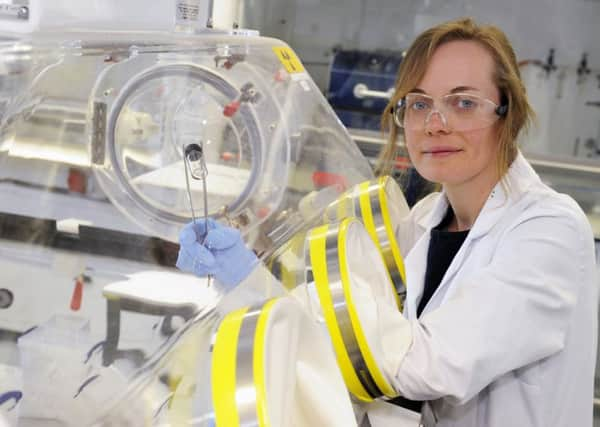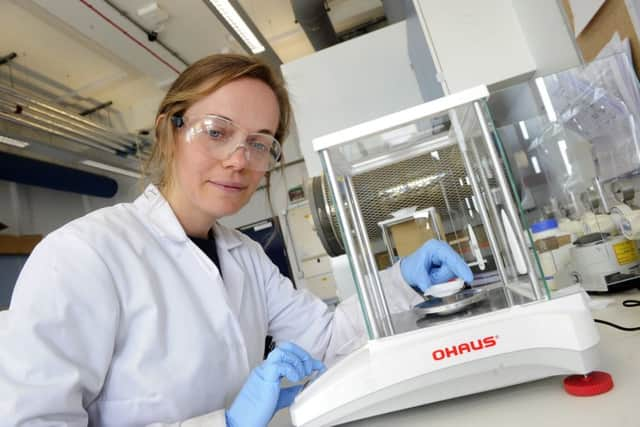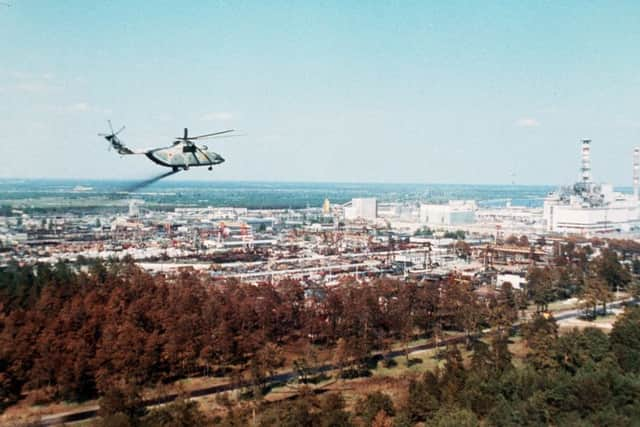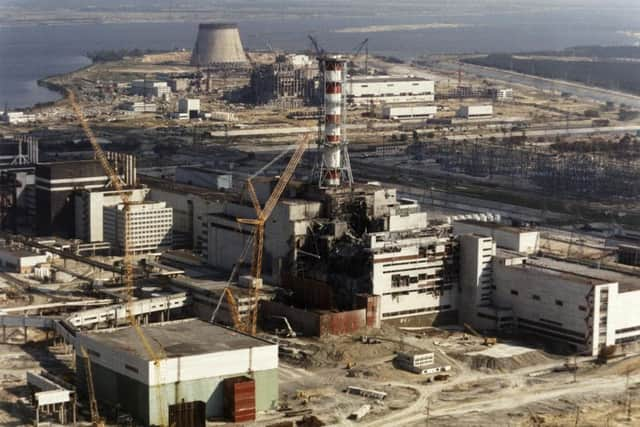Meet the Sheffield scientist clearing up the world’s nuclear waste


Climate change, rapidly-escalating tensions between the US and Iran, the outcome of Brexit – there are plenty of things for the ordinary person to worry about these days. But Dr Claire Corkhill believes there is another vital issue that requires greater public attention; how the UK safely disposes of its 650,000 cubic metres of nuclear waste – enough to fill Wembley Stadium – that will be radioactive for more than 100,000 years.
Advertisement
Hide AdAdvertisement
Hide AdIn addition to her vital research on the subject as part of a world-leading team at the Immobilisation Science Laboratory at the University of Sheffield and guiding PhD students with their work in the field, the 35-year-old’s passion for the subject has also seen her live-tweeting scientific observations about new Sky Atlantic mini-series Chernobyl and create a 35-minute documentary called We Should Be Talking About Nuclear Waste, which involved travelling to an underground disposal facility in Finland which there are hopes of recreating in this country.
“I’m on a bit of a mission to raise awareness about nuclear waste,” she says, with some understatement.
Dr Corkhill initially did a degree in geology at the University of Manchester before doing a PhD in Mineralogy and Geochemistry and then becoming involved in nuclear materials work in Sheffield, which has just been named as the best university in the country for income and investment in engineering research.
“I got involved with nuclear waste because I saw an opportunity to use the scientific skills I have learnt to kind of save the world,” she says.
Advertisement
Hide AdAdvertisement
Hide Ad“It is a grand thing to say but I want to make a difference.


“This stuff could kill a lot of people and it is really bad for the environment. We have seen what happened with Chernobyl. A lot of scientists see it as a way to make a difference and that is what motivates me.”
It is a bold claim but one that is backed up by her work in a laboratory overlooking Sheffield city centre. One of the projects she is currently involved in is examining how to deal with hazardous radioactive dust being created at the sites of the Chernobyl and Fukushima nuclear disasters.
The two events – Chernobyl in 1986 and Fukushima in 2011 – are the world’s two worst nuclear accidents and the only ones to be classified at Level Seven - the maximum possible - on the International Nuclear and Radiological Event Scale.
Advertisement
Hide AdAdvertisement
Hide AdChernobyl was caused by an explosion and fire in an operational reactor, with the fallout spreading for thousands of miles. The death toll from the event in what was Soviet Union-controlled Ukraine remains hotly disputed but dozens died as a direct result from blast trauma or acute radiation sickness, while thousands of cancer deaths are predicted to happen or already have been caused by it. The Fukushima disaster followed an earthquake and tsunami that led to three nuclear meltdowns at the site. Last year, Japan announced a worker at the plant had died after suffering radiation exposure and developing lung cancer that was diagnosed in 2016.


Corkhill says there were considerable parallels between the two disasters and that learning from previous research on Chernobyl is informing the approach to dealing with Fukushima, where it remains unsafe for humans to enter but robots have been sent in to take photographs.
Much of the site has been underwater as water was pumped in to cool the reactor after temperatures rose to over 2,000C in the meltdown. But this is causing corrosion which can create a fatal radioactive dust and needs to be taken into account when the time comes to remove the highly radioactive fuel debris from the site; an operation that is due to begin in 2021. Corkhill is involved with recreating the precise conditions inside Fukushima – down to the exact pipes, cement and stainless steel, as well as uranium – to help guide the removal operations.
“We had been the first people to accurately simulate what it looked like at Chernobyl. It is really like baking a cake. We managed to recreate the Chernobyl model and are confident we can do the same at Fukushima.
Advertisement
Hide AdAdvertisement
Hide Ad“Chernobyl happened 33 years ago but after the collapse of the USSR, Russia just left Ukraine to deal with it. They spend seven per cent of GDP trying to clean up Chernobyl. It will take a couple of hundred years. It should be much quicker in Japan, they want to clean it up as quickly as possible. Every time we go, the level of safety clothing you have to wear has decreased massively. They are doing a really good job and they plan to start taking the fuel out in 2021. This is going to take 25 years. I think the work we are doing is really going to help with planning to take the fuel out of the reactor.”


The lessons of the two disasters highlight the importance of Corkhill’s work closer to home – the safe disposal of the UK’s nuclear waste, most of which is kept at Sellafield in Cumbria. One element of the work is mixing small samples of dried high-level nuclear waste with glass, which is then solidified and sealed away.
“We work with the nuclear industry who scale them up to see if it can done on a larger scale,” she explains.
“Nuclear waste is going to be radioactive for over 100,000 years, some of it for millions of years. Our oldest man-made structures are only several thousand years old. We are not going to be around to see if our materials have done the job.”
Advertisement
Hide AdAdvertisement
Hide AdShe says a football analogy explains why safely disposing of high-level nuclear waste is so important.
“If the nuclear waste was on the centre spot of a football field and you were on the goalkeeper’s line, by the time you got to the 18-yard box, you would have received a fatal dose of radiation. It wouldn’t happen immediately but over the next few weeks of months you would probably die at some point.”
Corkhill says nuclear waste is a problem which she has seen first-hand across the world.
“We have had 70 years of the nuclear age. That came about through a real desire to build weapons to end the Second World War and then the Cold War. They built plants to produce plutonium so it was quicker to have the bomb. There were a lot of radioactive by-products but thinking about what to do with the waste was further down the list of priorities.
Advertisement
Hide AdAdvertisement
Hide Ad“In the US, I have been working on processes with the US Government where they are trying to clean up big grain silos they buried in the ground in Washington State after they had been filled up with nuclear waste and which have been leaking. When it was done, there was no thought of how to manage these things in the long-term.”
The Government’s long-term aim is to follow the example of Finland and create what would be known as a ‘Geographical Disposal Facility’ deep underground. But the £12bn project has been delayed after plans for the site in Cumbria were rejected by councillors in 2013. A search for a new location began last year with financial incentives expected to be on offer to communities which accept it.
She says in her opinion that new nuclear power stations should not be built in the UK until an effective disposal system – such as the planned underground facility – is in place.
Given the long-term nature of the challenge, Corkhill says she hopes her work will make a positive difference.
Advertisement
Hide AdAdvertisement
Hide Ad“For me, being able to influence Government policy on nuclear waste so they are making the right decisions would be a really great outcome. Even if it is just a sentence in a policy document, I will know I have made a difference.”
Fear from Chernobyl visit
Claire Corkhill says visiting Chernobyl was one of the few times she has felt fear around nuclear materials.
She went to the site, which is surrounded by a 1,000 sq mile exclusion zone restricting public access, in 2016 with a group from Sheffield University on an organised tour, which is the only way of access.
“It was roasting, 35C, but you had to wear sleeves down to your wrists and trousers down to your ankles. We did a tour of the reactor and went around Reactor Building 2. Reactor Building 4 was the one which blew up.
Advertisement
Hide AdAdvertisement
Hide Ad“When I am stood here in the lab, I have no fear of radiation because it is a controlled environment. When I was there, I didn’t know where it was coming from. That made me feel a little bit uncomfortable.”